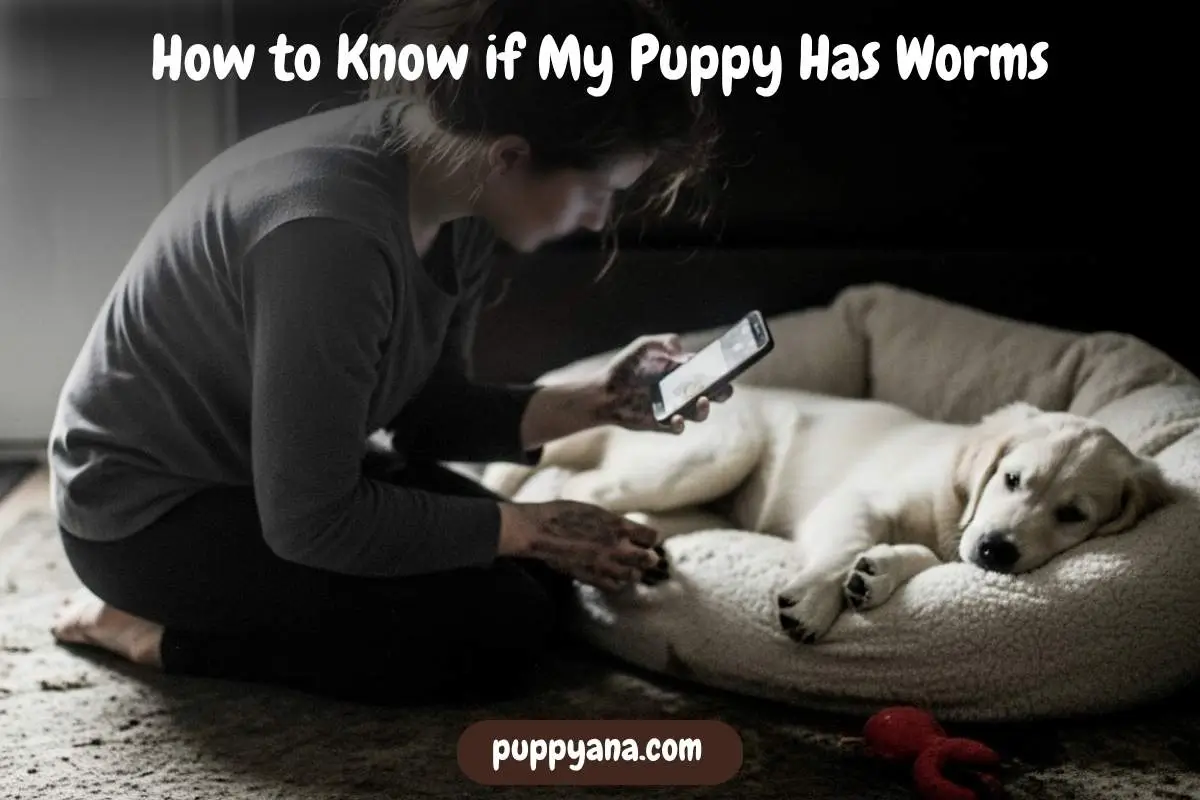Training a puppy takes focus and patience, but what if your puppy can’t hear you?
Many new pet parents ask:
“How do I train a deaf puppy if they can’t hear commands or my voice?”
The good news? Deaf puppies can learn just as much as hearing puppies, sometimes more. They just learn visually instead of verbally. With clear hand signals, body language, and trust-based routines, your deaf puppy can become a confident, well-behaved companion.
I’ve helped train several hearing-impaired dogs, including a white Boxer mix and a Dogo Argentino puppy born completely deaf. These dogs taught me, and dozens of owners, that with the right tools, you don’t need sound to raise a star student.
In this guide, you’ll learn:
- How to train a deaf puppy step-by-step
- Which tools and hand signals work best
- How to teach recall and stop unwanted behavior
- When to start training and how to build attention
- Tips from deaf dog handlers, puppy fosters, and professional trainers
You’ll also get help from well-respected sources like AKC, VCA, and ASPCA to make sure every step is safe and positive.
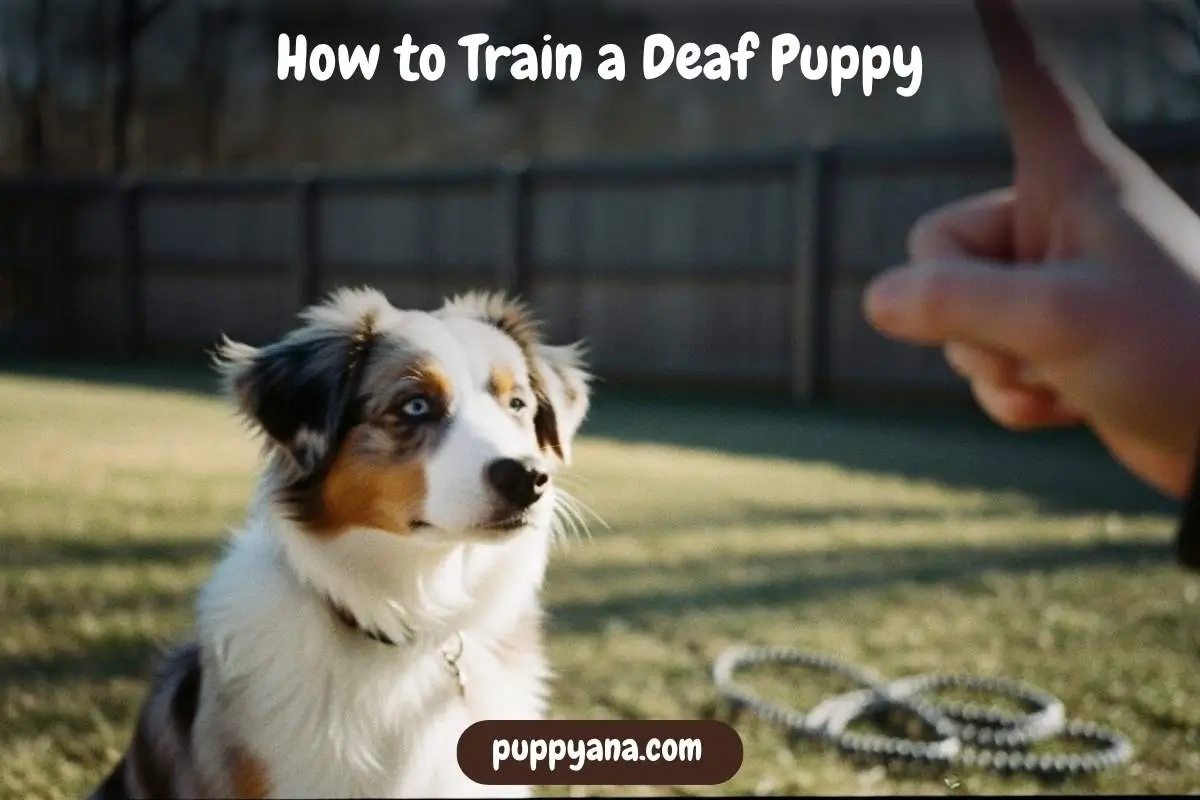
Table of Contents
ToggleHow to Train a Deaf Puppy: Quick Look at What You Need
Before jumping into training, you’ll need to set up your training space and gather reliable tools.
Essentials for deaf puppy training:
- A treat pouch, high-value soft treats
- List of hand signals or gestures you’ll use (more on this soon)
- A vibration collar (optional, for attention—not correction)
- A small LED flashlight or penlight (for recall at night)
- A long line leash for outdoor recall training
- A calm, distraction-free space to get started
Real-life tip: I trained my 12-week-old deaf foster pup in the hallway at first—it removed distractions and doorways. Once she connected eye contact to rewards, we moved outside.
9 Proven Steps to Train a Deaf Puppy
Deaf dog training is about clarity, visual guidance, and positive reinforcement. You’re replacing voice with hand signs, routines, and touch, but your dog is still fully capable of learning.
1. Teach Name Recognition With Eye Contact
Before sit, stay, or anything else, you need your puppy’s eyes on you.
You’re not teaching their name the way a hearing dog learns it. Instead, you’re teaching:
💡 “When I look at you, good things happen.”
How to do it:
- Wave your hand slowly inside your pup’s field of vision
- As soon as they look at you, mark the moment with a thumbs-up and give a treat
- Repeat 10–15 times across short sessions
- Eventually, looking at you becomes their “cue” to pay attention
Use a “watch me” hand signal (like pointing to your eye) before giving any command.
2. Use Consistent Hand Signals for Basic Commands
Deaf puppies learn patterns. Choose one hand gesture per command and use it every time.
Common hand signals to teach:
| Command | Hand Signal |
|---|---|
| Sit | Palm upward, move hand up slowly |
| Stay | Palm facing dog, like a “stop” sign |
| Come | Two-hand signal to chest or open arms |
| Down | Flat hand, palm down, move toward floor |
| Yes/good | Thumbs-up |
| No/stop | Flat hand, side to side motion |
PuppyAna recommends teaching no more than one or two new signals per week at first to avoid confusion.
Start with “sit,” “yes,” and “come”. These build your foundation for everything else.
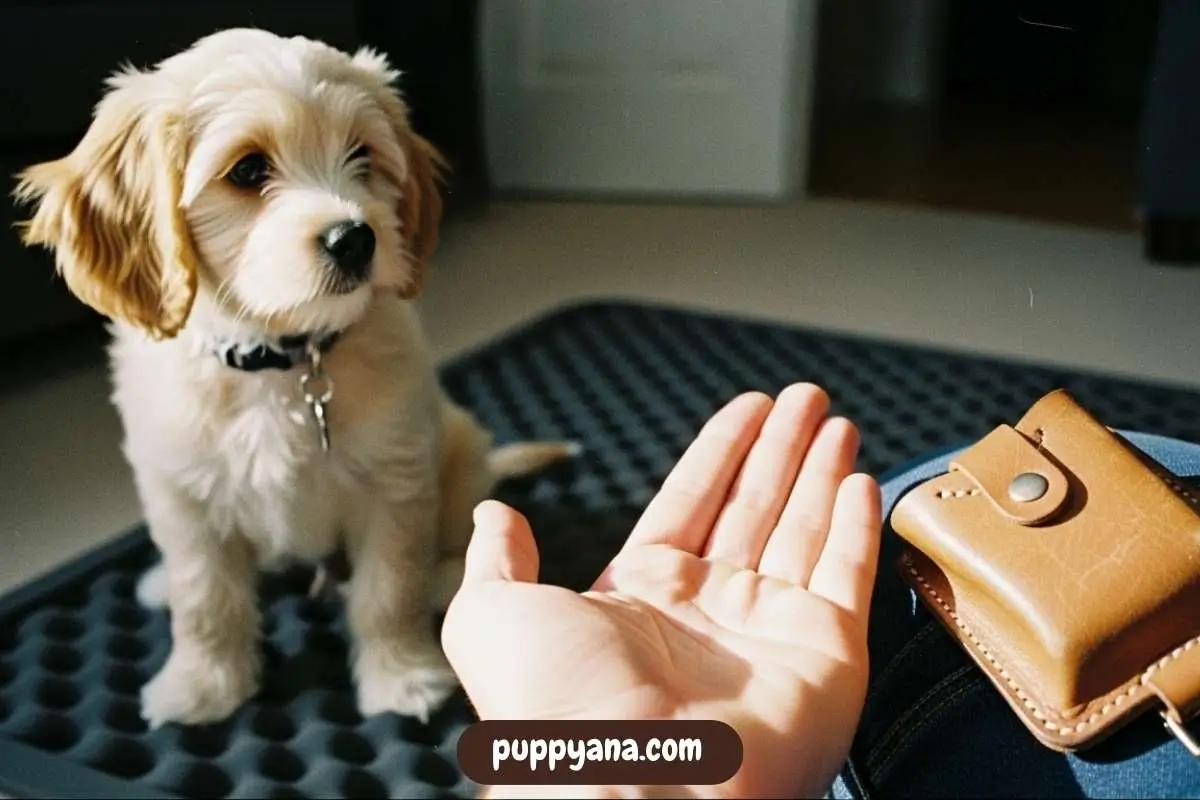
3. Use a Thumbs-Up as a Marker Word
Since deaf dogs can’t hear a clicker or “yes,” you’ll need a visual version.
A thumbs-up sign or a small light flash (like from a penlight) works beautifully.
Steps:
- Give hand signal
- Puppy responds correctly
- Flash thumbs-up immediately
- Reward with a treat
I taught my deaf Aussie pup this visual marker in just two days. Every thumbs-up = a high-value treat. Soon, it became her “clicker.”
4. Create and Reinforce Daily Routines
Structure plays a bigger role in deaf puppy learning.
Use visual patterns and consistent environments like:
- Lights on for wake-up
- Hand gesture to go outside
- Placing food bowl means it’s meal time
- Tapping crate gently before sleep
The more predictable the day, the more mentally safe your deaf dog feels.
5. Teach Recall with Vibration or Visual Signals
Deaf dogs can learn recall (“come”) just like hearing dogs, but they respond to sight or feel.
Tools:
- Short sessions with a long leash
- Hand signal and running backward/pat chest
- Optional: vibration collar (NOT a shock collar)
How to train:
- Let puppy explore 8–10 feet away
- Tap the ground or vibrate collar briefly
- As they look up, give “come” signal
- Treat heavy when they reach you
One client used a flashlight tap on the floor in low-light areas. Deaf puppies quickly learn to associate light = attention + reward!
Learn more from the AKC’s guide on training deaf dogs, including recall games.
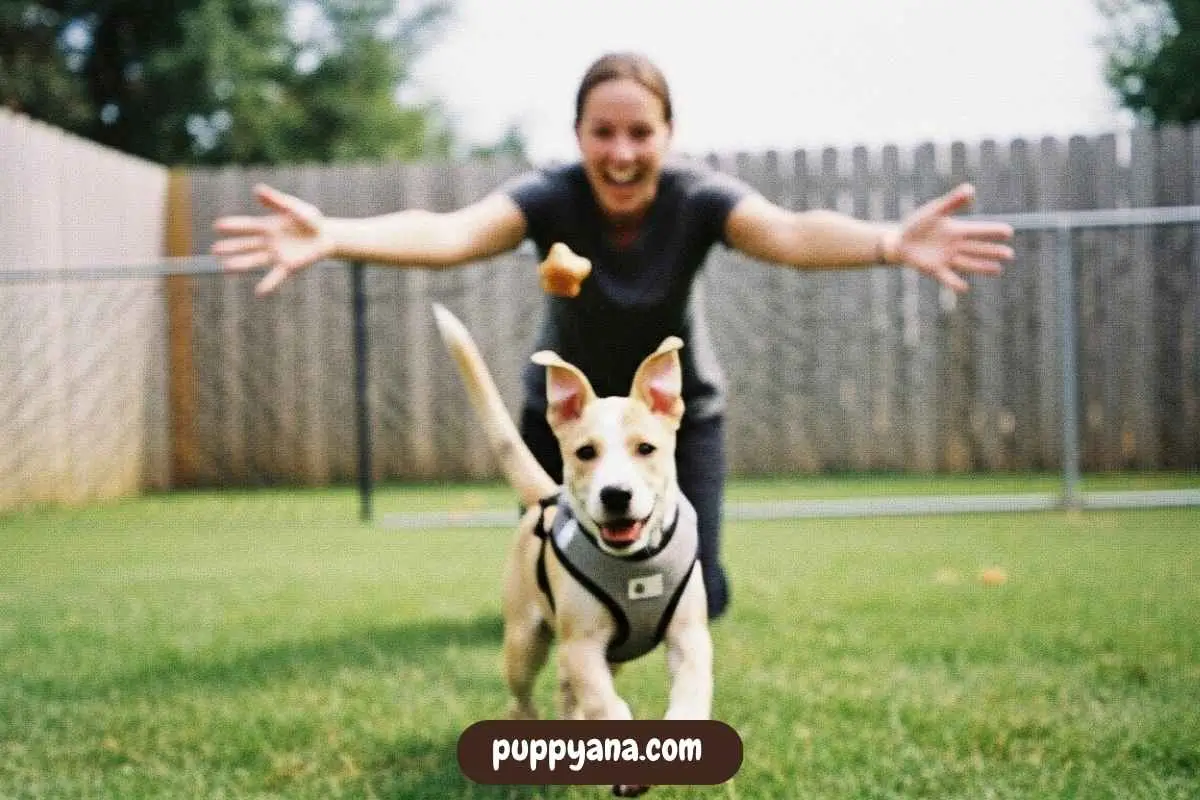
6. Use Gentle Touch to Get Attention
Physical touch should be positive and never startling. It’s your dog’s secondary communication system.
Teach your dog that:
- A tap on the shoulder or flank = look at you
- A gentle chin-touch or massage = safety
- Waking touch = awareness, not punishment
I always tapped my pup’s side gently before snapping a leash on. It avoided surprise and built clear associations.
7. Be Aware of Surprises and Startle Responses
Because deaf pups can’t hear approaching people or loud noises, they may be more prone to sudden fear reactions.
Train for this.
Tips to help:
- Wake your puppy gently by touching a blanket they’re lying on
- Avoid waking them by touching their face
- Let visitors approach from the side, not behind
- Pair surprises with high-value treats over time
With trust and careful socialization, startles fade.
8. Socialize Using Visual Cues and Gentle Redirection
Deaf puppies can thrive with other dogs and people if visual control and safe introductions are consistent.
Make your own cue for “break” or “enough” to stop play. Use calm hand gestures instead of voice correction.
Supervise dog-to-dog play closely. Step in as needed using body blocks or leash guidance.
PuppyAna recommends pairing social experiences with hand-targeting games to prevent rough or reactive behavior cues.
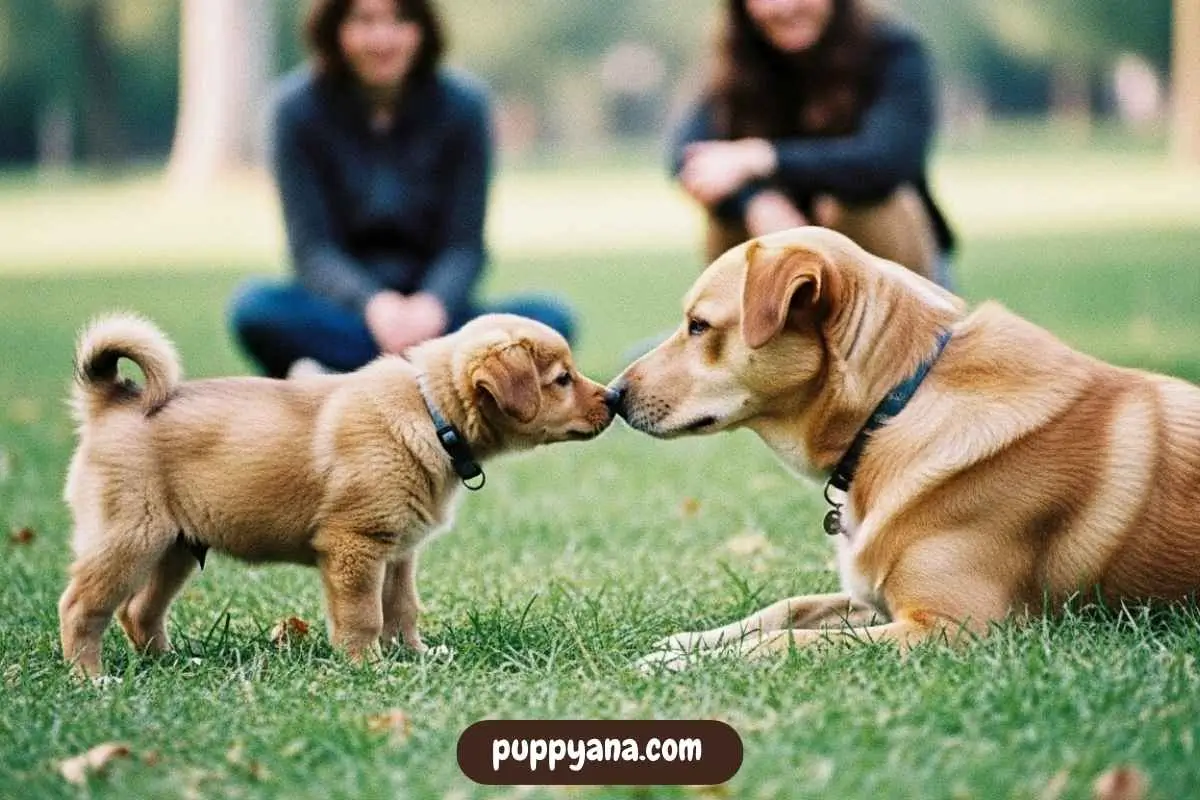
9. Celebrate Progress with Food, Play, and Calm
Your puppy may not hear your applause, but they’ll feel your energy, touch, and routine rewards.
Use:
- Treat lotteries: Sometimes more treats = more motivation
- Tug or toy play
- Cuddles if your dog enjoys them
- Visual “nice job” cues like chest pats or claps they can see
Keep sessions short—5 to 10 minutes. End with a win.
I end all tutorials with 1-on-1 play. My deaf foster, Willow, loved chasing a flirt pole in a quiet backyard. That became her “happy signal.”
How to Keep a Deaf Puppy Safe During Off-Leash Play
Letting a deaf puppy run off-leash can feel risky, but there are safe ways to prepare them for freedom in open spaces like dog parks, trails, or fenced areas.
Here’s how to build up to safe off-leash time:
✅ Safety Tools:
- Long-line leash (15–30 ft.) for gradual recall work
- GPS-tag collar or AirTag holder for backup security
- Vibration collar with a consistent “check-in” signal
- Bright leash attachment or reflective harness for visual visibility
✅ Practice steps:
- Train recall in fenced yards or dog-safe parks with zero distractions
- Add small distractions, practice recall
- Remove leash gradually when puppy consistently responds to visual or vibration cues
- Avoid large off-leash areas with loud/distracting dogs or wildlife
Example: One foster I worked with gained off-leash access after 2 months of consistent recall from 30+ feet using a vibration cue followed by visual recall + high-value treats.
Deaf dogs can enjoy off-leash life, but only with solid visual control, clear trust, and proven recall.
Should You Use a Vibration Collar to Train a Deaf Puppy?
A vibration collar (not a shock collar) can be a helpful tool to get your deaf puppy’s attention when used responsibly.
But it’s not a remote-control or punishment. It should always be introduced slowly and paired with positive experiences.
When to consider it:
- If your puppy ignores visual signals due to distraction
- During off-leash recall sessions
- As a backup way to gently gain attention outdoors
Never use a vibration collar to:
- Punish your puppy
- Startle them harshly
- Stop behavior without positive redirection
How to introduce it safely:
- Fit the collar properly and test the vibration yourself
- Gently touch your pup, then activate the vibration
- When they look at you, reward immediately
- Repeat in short neutral sessions, never when startled or scolding
Real-world lesson: I used a single vibration cue, followed by a “come” hand signal and a jackpot treat. My deaf Dachshund learned it meant “look at mom.”
What Breeds Are Most Likely to Be Born Deaf?
Some dog breeds are more likely to be born deaf, especially dogs with white coats, merle patterns, or blue eyes due to their genetics.
Breeds with higher congenital deafness risk:
- Dalmatians
- Australian Shepherds (merle lines)
- Bull Terriers
- English Setters
- Great Danes
- Boxers (especially white)
- Catahoulas
- Border Collies (merle or double merle)
- Boston Terriers
- Jack Russell Terriers
According to VCA Hospitals, some dogs are born deaf in one ear (unilateral) or both (bilateral). BAER testing (Brainstem Auditory Evoked Response) is the only way to definitively diagnose hearing in puppies.
Example: My client’s double merle Aussie saw no training progress early on. A hearing test confirmed full deafness. Once we switched to 100% visual cues, training skyrocketed.
Knowing your puppy’s breed background can help you catch deafness early and adjust your approach from day one.

Conclusion
Training a deaf puppy may feel intimidating at first, but it’s simply a different language. These loyal, smart, and visually intuitive dogs can thrive when taught with patience, eye contact, and trust.
By mastering hand signals, using thoughtful visual cues, and creating a predictable routine, you’ll build an unshakable bond with your puppy, one built on clarity, not commands.
Your puppy doesn’t need to hear your voice to feel your love.
Frequently Asked Questions
Can I train a deaf puppy without a vibration collar?
Yes. Use visual cues, hand gestures, flashlight training, or gentle touches. Vibration collars add options—but aren’t required.
How early should I start training a deaf puppy?
Start at 8–10 weeks like any puppy. Their brain is ready for visual learning early.
What causes puppies to be born deaf?
Deafness is often genetic—common in white-coated dogs (Dalmatians, Boxers, Bull Terriers).
Can my deaf dog still live a full life?
Absolutely. Deaf dogs can live happy, healthy lives with extra communication skills and safety awareness in place.
How can I get my family on board with visual training?
Use a shared hand signal chart, post it in your home, and agree on consistent reward methods. Clarity is key.

